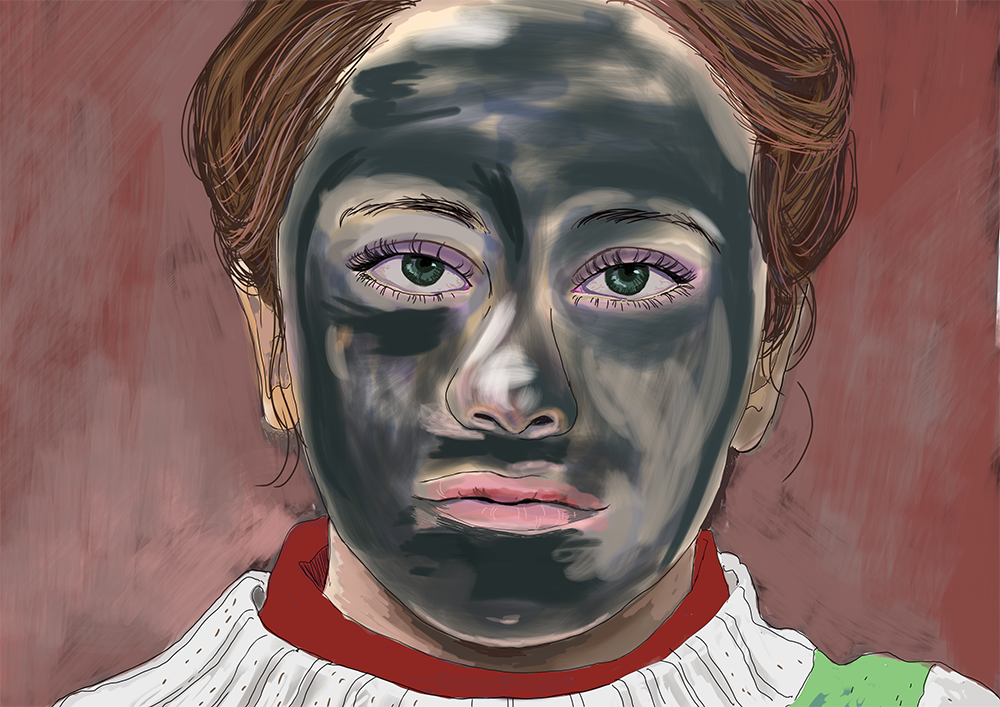2024年4月10日開催
実に4年ぶりの第43回さいくりシネマテークは、歴史に残る、残していかなければならない名作でした。
今回はこの映画をご紹介くださった篠﨑さんに、絵と文章を御願いしました。
ぼくたちは見ない
久しぶりの上映会は、私の強い希望で『ぼくたちは見た ガザ・サムニ家の子供たち』を取り上げてもらった。監督の古居みずえさんの講演を聴いたのがきっかけで、ずっと観たかったのである。
2008-2009年が舞台であり、去年の10/7以降の凄惨な大虐殺はまだ始まってはいないのだが、それ以前からイスラエルによる占領と封鎖がかなりの影響力を持って存在し、時に殺戮や暴力が人々の生活に深い傷痕(夥しい鮮血を伴う)を残していくことが、子供たちの話や、話す子供の背後に映る瓦礫の山や半壊の住居から読み取れる。
子供たちはトラウマ状態にある。トラウマ状態というのが精神科的に正しい語なのかはわからないが、とにかく素人が観てもうつ状態でイライラしていて不安定だ。彼らはインタビューの節々でにっと口角を上げて見せる。それは笑うのとは少し違って、何が違うのかは説明出来ないのだが、とても悲しい。
「家族が亡くなった場所だから、この家に来るのが好きなの。住みたいくらい」
聡明な少女ゼイナブはそう言って、口の端を少し上げる。
子供のケアセンターという施設があり、子供たちはみんなで遊んだり絵を描いたりする。私はゼイトゥーンの街の大人たちも努力していると思った。子供のメンタルケアもそうだが、親が殺された子供を親戚が引き取り面倒をみている。ガスが無くても薪で料理をして、貯水槽を修繕し、日々を繋いでいる。私は毎日料理をするので、彼らの炊事のシーンを興味深く見ていたが、限られた設備で沢山のパン(魅力的な丸いパン!)を焼き、大皿のおかずを用意するゼイナブの叔母に、力強さを感じた。毎日の営みの積み重ね、子供たちの見せる緩やかな回復の道筋、そういった尊い生きる希望が、映画には示されている。イードのお菓子、カタイフを包むゼイナブの様子は、回復と成長が見えてやはり力強い。
しかし周知の通り、現在進行形でイスラエルによる未曾有の虐殺が起きている。オリーブの木を植える象徴的な場面に満ちていた希望の光は、潰えた可能性が高い。子供たちは今は20代か30歳くらいだろうか。生きているだろうか。映画はガザ南部の街ゼイトゥーンを取材していたが、今は最南のラファが攻撃されている状況である。人々はどこに逃れたのだろうか。逃れる場所はあるのか。
序盤に子供たちが学校で歌を歌うシーンがある。
「世界は私たちのことを忘れてしまった」
私たちは血塗れのパレスチナの人々から目を逸らしては行けない。イスラエル兵の蛮行からも目を逸らしてはいけない。そのどちらも自分と無関係ではないはずである。見つめることは苦しい。でも本当は脳みそが出て目玉が出て体がばらばらになる様子を、子供に見せている場合ではない。世界中の大人は、イスラエルによるジェノサイドを制止しなければいけない。まずはそっと目を開けてほしい。パレスチナのことを知るきっかけにするには充分な一本だと思う。
Screening 10 April 2014
The 43rd Saijo Clinic Cinematheque, held for the last time in four years, screened a masterpiece that has left its mark on history and must be preserved.
This time, we asked Ms. Shinozaki, who introduced this film to us, to draw pictures and write an essay for us.
We Don’t See It
For my first screening in a while, I was asked to feature “Bokutachi wa Mita (What we saw): The Children of the Gaza Samouni Family” at my strong request. I had been wanting to see the film ever since I heard the director, Mizue Furui, give a lecture on the subject.
The film is set in 2008-2009, and although the horrific massacre after last year’s October 7 has not yet begun, the Israeli occupation and blockade existed with considerable influence even before then, and sometimes the carnage and violence left deep scars (with a great deal of fresh blood) on people’s lives, as the children’s stories and The piles of rubble and half-destroyed dwellings behind the children’s stories are a reminder of the traumatic state of these children.
The children are in a traumatized state. I am not sure if “traumatized” is the correct psychiatric term, but even to a layman, they seem depressed, irritable, and unstable. They smirk at the corners of their mouths at various points in the interview. It’s a little different from laughing, and I can’t explain what the difference is, but it makes me feel very sad.
“I like coming to this house because it’s where my family died. I want to live here so much,”
says Zainab, a bright girl, and the corners of her mouth turn up a little.
There is a children’s care center where all the children play and draw together. I thought the adults in the city of Zeitoun were making an effort, too. As well as mental health care for children, relatives take in children whose parents have been killed and take care of them. Even without gas, they are cooking with firewood, repairing water tanks, and keeping their days together. I cook every day, so I watched their cooking scene with great interest, but with limited equipment, they bake a lot of bread (attractive round bread!) ) and preparing a large plate of side dishes with limited facilities, I felt a sense of strength from Zainab’s aunt. The film shows the accumulation of daily activities, the gradual path of recovery shown by the children, and the precious hope for life. Zainab’s wrapping around the Eid snack, kataif is also powerful, showing recovery and growth.
But as is well known, there is an ongoing, unprecedented slaughter by Israel. The glimmer of hope that filled the symbolic scene of planting olive trees has likely been crushed. The children are probably in their 20s or 30s now. Are they still alive? The film covered the southern Gaza town of Zeitoun, but now the southernmost town of Rafah is under attack. Where have the people fled to? Are there places to escape to?
There is a scene early in the film where children sing a song at school.
“The world has forgotten us”.
We cannot turn our eyes away from the bloody Palestinian people. We must not look away from the barbarism of the Israeli soldiers. Neither of these should be unrelated to us. It is painful to stare. But the truth is, this is not the time to show our children how their precious family members and relatives’ brains come out, eyeballs fall out, and bodies fall apart. Adults around the world must stop the genocide by Israel. First and foremost, I want you to gently open your eyes. I think this film is good enough to trigger your knowledge of Palestine.
![Saijo Clinic Blog | 新宿 西條クリニック [心療内科 精神科 メンタルクリニック]](/wp-content/uploads/2016/03/header_logo.gif)
